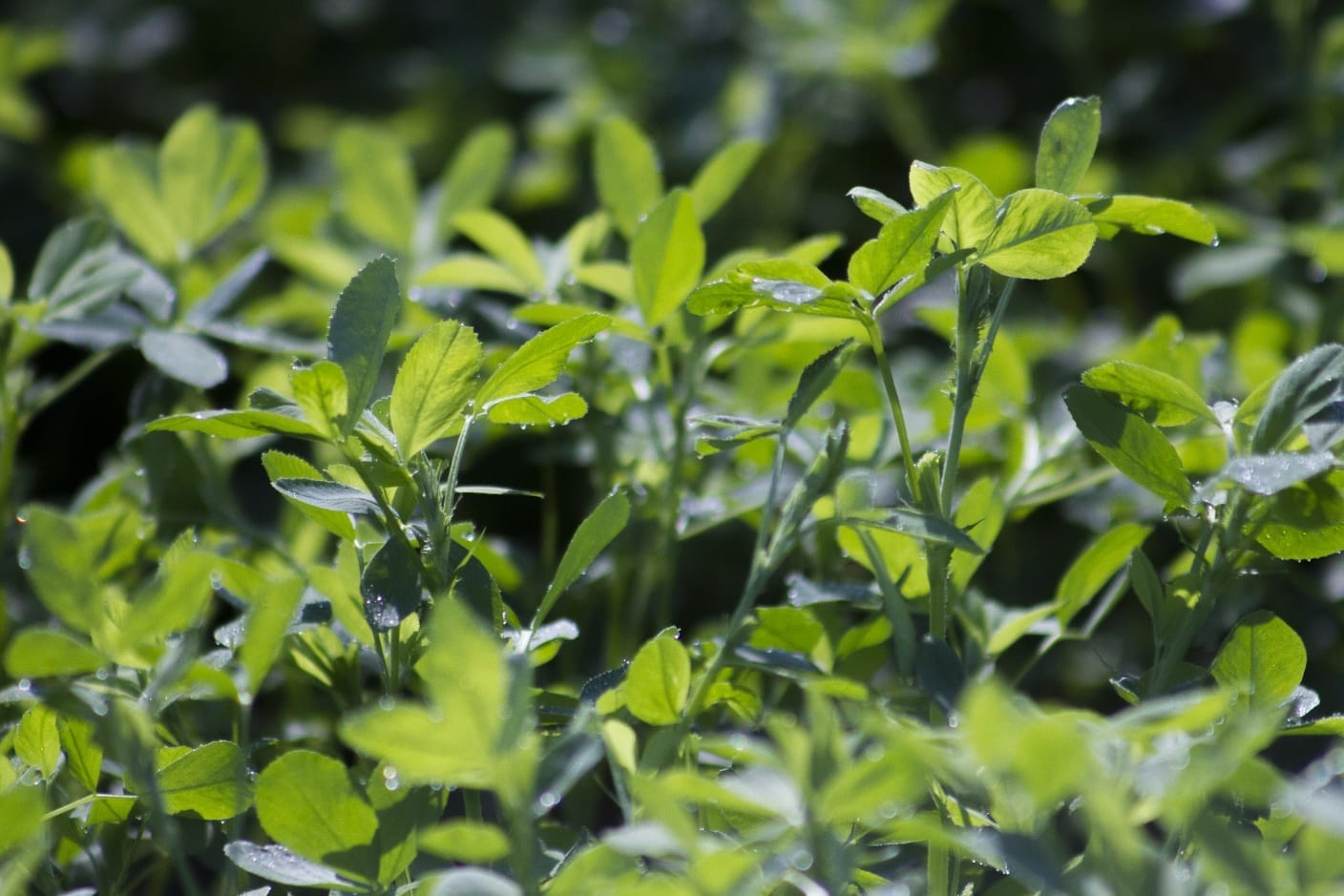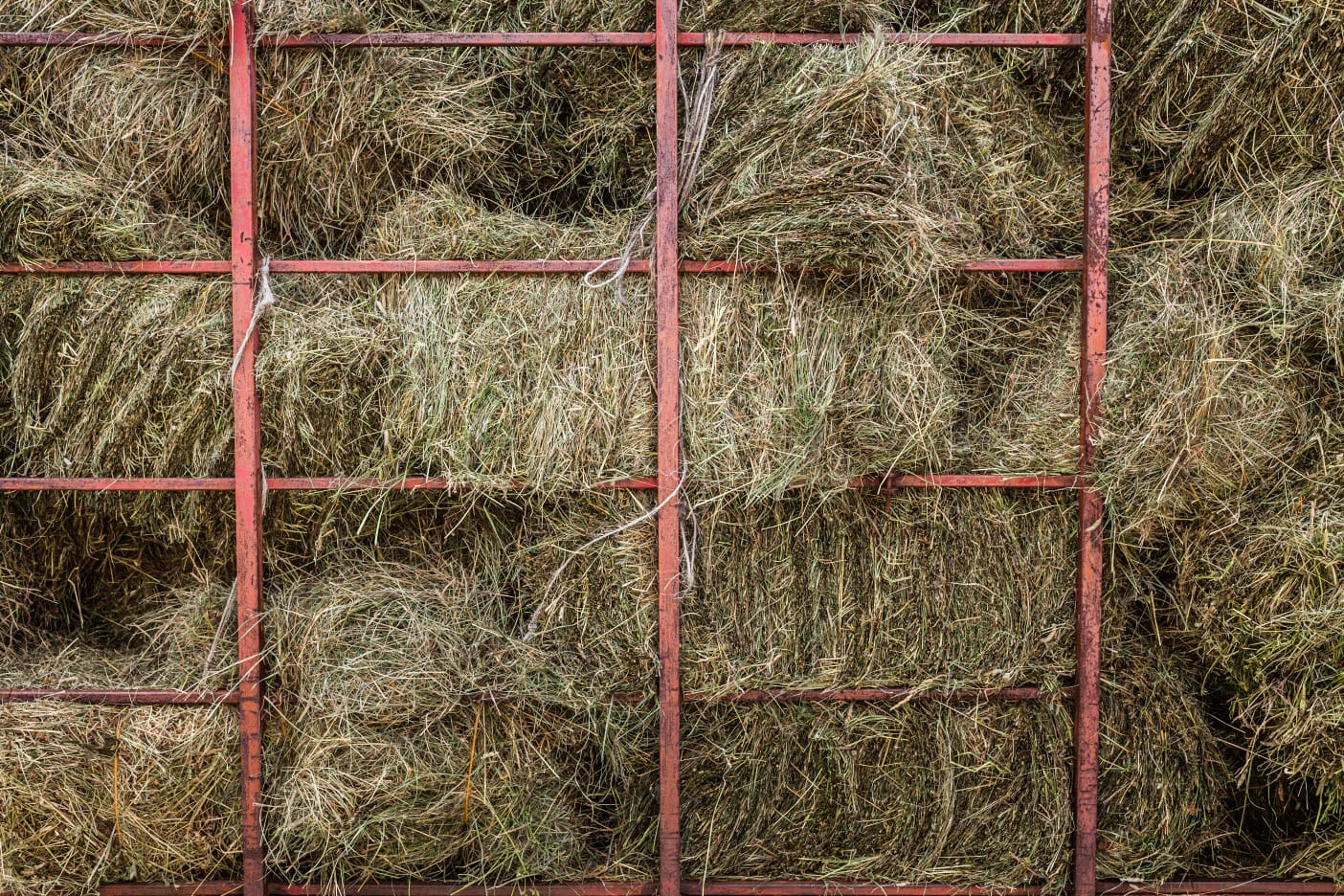You already know that Lucerne is called the queen of forage for its high nutritive value and also cause it’s just so darn tasty that cows love to wolf it down!
Harvesting Lucerne for hay or baleage is also a great way to keep your animals healthy other than just grazing. It’s like simmering your fresh strawberries into a tasty jam that you spread on crispy toast to keep yourself warm and fuzzy during the winter.
In this article, we’re going to talk all about Lucerne in all its versatile glory!
Lucerne is especially beneficial to animals when it’s harvested at an early growth stage, ie. when it has the highest amount of protein and the lowest amount of fiber.

We know that as a farmer, one of the biggest difficulties you face is getting the right forage that will meet your cows’ energy demands.
The protein that’s present in Lucerne hay is very easily digestible and gets cleared from the rumen in a jiffy. The cows feasting on said Lucerne in turn feel as light as a feather and continue to intake high amounts of the feed which then helps them produce more milk!
The first cutting of Lucerne:
The first cutting of Lucerne has the highest yield and quality.
The most important factor in determining the quality of Lucerne is its maturity at the time of harvest. When Lucerne matures, its fiber content goes up and its fiber and DM (dry matter) digestibility decrease.
But, the timing is everything. Your timing could turn Lucerne from a highly productive source of hay for your animals to a pile of substandard cattle feed. If the Lucerne is harvested at an immature stage, its fiber level ends up being too low which doesn’t meet the needs of high-producing cows. Harvesting early also lowers the life of the Lucerne stands.
Sometimes, some producers delay the harvest process waiting for the maximum yield in their Lucerne.
But as they say, make hay while the sun shines – because a delayed harvest could mean a decline in the quality of Lucerne which in turn sets of a whole row of dominoes that affect animal health milk production and number crunching at your farm.
The yield of the first cutting of Lucerne is the largest of the year and makes up nearly 35% to 40% of the year’s total crop.
Lucerne for high producing lactating dairy cows:
When Lucerne is fed to high producing lactating dairy cows, it should be harvested at 40 percent natural detergent fiber or NDF content. At this 40% level, the cow has enough fiber for normal rumen function and can maintain a feed that’s conducive to a good production of milk.
Harvesting 101:
We cannot stress enough about the fact that the yield of Lucerne dry matter is the maximum at the first cutting so we’re going to say it again – the yield of Lucerne DM is at its highest at the first cutting, so, making sure you get your proper NDF levels is very important.
You could always use a pasture measurement service like pasture.io to help you decide when your Lucerne pastures need their first cutting based on it's growth rate.
Goals of harvesting Lucerne:
There are three main goals that one should keep in mind for harvesting Lucerne:
- High quality
- High yields
- Maximum persistence
To achieve high quality:
You need to do the first cutting during the early bud stage and the remaining cuttings should be taken in the mid-bud stage.
Some producers have some tricks up their sleeves like repeatedly early cutting in the hope that it will increase quality but no, all that does is reduce stand persistence.
There usually needs to be a gap of 28 to 33 days before the first and second cutting. And another 30 – 35 days between the remaining cuttings.
Due to rapid changes in quality, especially for the first cut, the forage must be harvested in about 3-4 days. Late fall cutting is not recommended because Lucerne needs to stockpile on its reserves before winter calls!
Let’s talk winter
Lucerne must be allowed to build its energy reserves before winter. This is an important characteristic that will help Lucerne survive winters with good stand persistence.
Once the third/fourth harvest is done, there should be a period of absolutely no harvest before the first killing frost. Lucerne must be given enough of a rest and recovery period before the stage of winter dormancy starts.
Consider TNC
TNC or total non-structural carbohydrates are the sugars and starches that are present in the roots and crowns of Lucerne.
It is this TNC that supplies the plant with energy during the dormant season, during early spring growth and regrowth after each harvest.
To achieve high yields:
The first cutting should be done at the bud stage. And the second cutting about a month after the first cutting.
During summers, the quality of Lucerne changes more slowly which gives you a 7 – 10 day harvest time period.
To achieve maximum persistence:
The first cutting is between 1st flower and 25% flowering and then allowing about 35 – 40 days between the next round of cuttings. This format allows you a longer harvest period but, the quality, in this case, is usually lower than what is required for high levels of production.
Now while following these tried-and-tested techniques is a surefire way to get the most out of your harvest, the yield and quality also depend on the process of harvest and the storage capacities.
A lot of hay losses are due to handling or also due to weather in the field. Leaves are usually more prone to losses than the stems.
A good tip to remember is to cut Lucerne in the morning so that you get a full day’s drying, you’re minimizing respiration loss and also reducing the risk of the Lucerne being exposed to some unwelcome weather.
Another reason to cut Lucerne in the morning is that some studies have proven that late afternoon cutting increases the soluble sugar levels in Lucerne compared to cutting in the morning.
Hay per cow:
Mature beef cattle can adjust with any sort of hay but lactating cows need hay with adequate protein that’s palatable.
Young calves have tender mouths that cannot chew coarse hay. For them, an offering of fine, soft hay that is cut before the bloom stage works well because it is much easier to eat.
Dairy cows, of course, need the best and highest quality of hay. Dairy cows prefer to eat fine, palatable hay than the coarse variety.
Storing Hay:
If you plan to store your hay for a longer time, say a couple of months, you need to store it right so that it doesn’t get spoiled.

Make sure it doesn’t get wet or even if it’s stored dry, it shouldn’t draw moisture up from the ground.
The best way to store hay is to build a hay shed with gravel so that moisture drains easily and the haystack is kept as dry as well, hay!
There are many aspects to harvesting Lucerne but hay (sorry, we couldn’t resist) if you’re able to harvest a high yield of top-notch quality Lucerne it will lower your overall feed costs as you will end up having to purchase lesser supplements or substitute forages.
And lower costs means more ka-ching!
Interested to learn more? Read our free guide on Everything you need to know about Pasture Grazing Management.
Until we meet again, happy farming!
- The Dedicated Team of Pasture.io, 2021-01-11